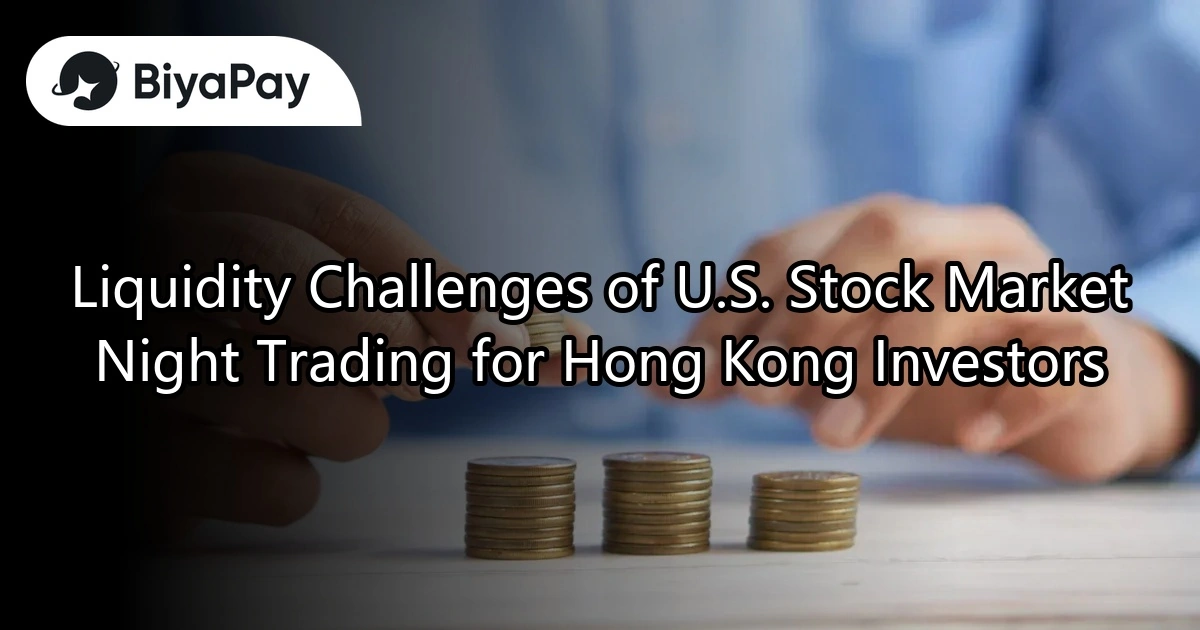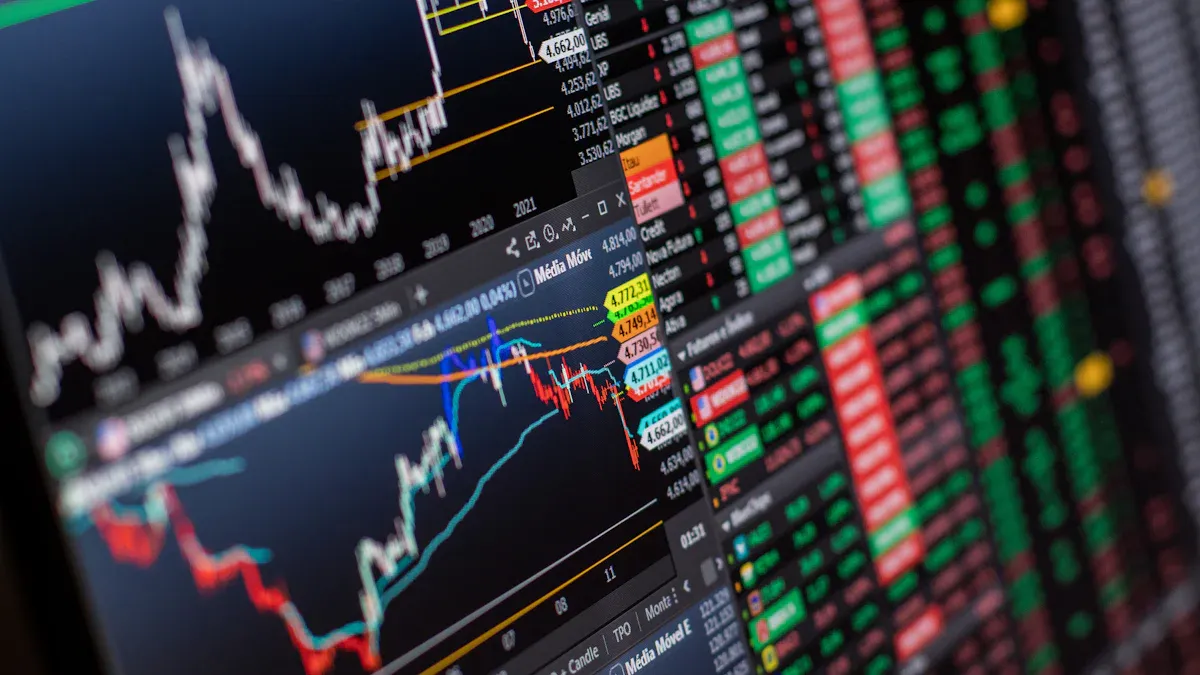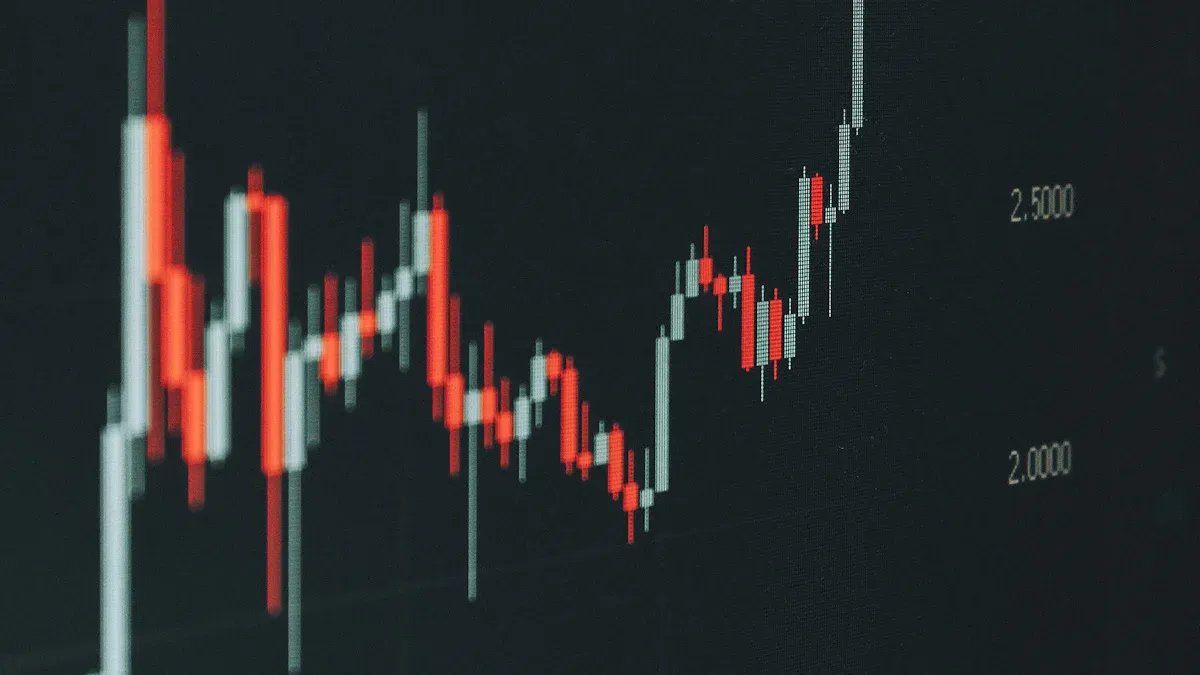- EasyCard
- Trade
- Help
- Announcement
- Academy
- SWIFT Code
- Iban Number
- Referral
- Customer Service
- Blog
- Creator
Liquidity Challenges of U.S. Stock Market Night Trading for Hong Kong Investors

Image Source: pexels
During the night trading session, the liquidity of the U.S. stock market significantly decreases. Hong Kong investors often face three major challenges: transaction difficulties, increased price volatility, and information delays. The U.S. stock market closing time has a 13-hour time difference with Hong Kong, and pre-market and after-hours trading sessions also affect local investors’ operations. U.S. holidays and the T+1 settlement system further increase trading inconveniences. Investors should consider how low liquidity during the night session impacts their decision-making and risk management.
Key Points
- The liquidity of the U.S. stock market significantly decreases during the night session, and Hong Kong investors often face transaction difficulties and increased price volatility during night trading.
- The U.S. stock market trading hours have a 13-hour time difference with Hong Kong, requiring investors to adjust their schedules and pay attention to the impact of U.S. holidays and the settlement system.
- The bid-ask spread widens during the night session, increasing transaction costs, and investors should prioritize high-liquidity popular stocks and use limit orders to control risks.
- Information updates are slower during the night session, and investors should choose reliable platforms and closely monitor market data to avoid missing trading opportunities.
- Split trading and the use of automated trading tools can effectively reduce the risks of night trading, improving transaction efficiency and capital management capabilities.
U.S. Stock Market Closing Time and Night Trading

Image Source: pexels
Trading Session Distribution
The U.S. stock market closing time has a significant impact on Hong Kong investors. The U.S. stock market is divided into three main trading sessions: pre-market, regular trading, and after-hours. The corresponding times in Hong Kong are as follows:
| Trading Session | U.S. Time | Hong Kong Time (DST) | Hong Kong Time (Non-DST) |
|---|---|---|---|
| Pre-Market Trading | 04:00-09:30 | 16:00-21:30 | 17:00-22:30 |
| Regular Trading | 09:30-16:00 | 21:30-04:00 | 22:30-05:00 |
| After-Hours Trading | 16:00-20:00 | 04:00-08:00 | 05:00-09:00 |
The U.S. stock market closing time varies due to daylight saving time adjustments, and investors need to pay close attention. The after-hours trading session is primarily conducted through electronic communication networks (ECNs), with transactions mostly being limit orders and lower liquidity. While this period allows investors to react instantly to major news, it also brings risks of wider spreads and transaction difficulties.
Time Difference and Schedule Challenges
Hong Kong has a 13-hour time difference with the U.S. East Coast. The U.S. stock market closing time usually falls in the early morning in Hong Kong, requiring investors to adjust their schedules to participate in regular trading sessions, which can easily affect physical health. Pre-market and after-hours trading sessions occur in the evening and early morning in Hong Kong, respectively, making participation more challenging for those with full-time jobs or studies.
U.S. holidays also affect the U.S. stock market closing time, with the market closing entirely or early on certain days. Investors should regularly check the official calendar to avoid missing trading opportunities due to holidays. Additionally, the U.S. stock market uses a T+1 settlement system, meaning transactions are officially settled one business day after completion. This places higher demands on Hong Kong investors for capital allocation and risk management.
Professional Advice: Investors should flexibly choose participation sessions based on their schedules and risk tolerance, and plan capital usage in advance to minimize inconveniences caused by the U.S. stock market closing time and settlement system.
Liquidity Characteristics

Image Source: unsplash
Night Session Trading Volume
During the night session, the trading volume of the U.S. stock market significantly decreases. Most investors and institutions complete their main transactions during regular trading hours. During the night session, the number of market participants decreases, leading to reduced trading volume. This situation is particularly evident during the after-hours trading session. Low trading volume makes it harder for investors to complete transactions instantly, especially when handling larger orders.
Popular stocks like Apple (AAPL) and Tesla (TSLA) still have some trading volume during the night session, but it is significantly lower compared to regular hours. Less popular stocks, such as small biotech companies, have even lower trading volumes during the night session, sometimes experiencing extended periods without transactions. Investors trading less popular stocks during the night session may need to wait longer to complete transactions.
Professional Tip: Investors should prioritize high-liquidity assets to reduce the risk of transaction difficulties during the night session.
Bid-Ask Spread
Low liquidity during the night session directly affects the bid-ask spread. During regular trading hours, popular stocks typically have narrow bid-ask spreads. For example, Apple (AAPL) may have a bid-ask spread of USD 0.01 to 0.03 during regular hours. However, during the night session, this spread may widen to USD 0.10 or more. For less popular stocks, the situation is more pronounced, with bid-ask spreads sometimes exceeding USD 1.
The following table shows the bid-ask spread differences for popular and less popular stocks across different sessions:
| Stock Type | Regular Hours Bid-Ask Spread | Night Session Bid-Ask Spread |
|---|---|---|
| Popular Stocks | 0.01-0.03 USD | 0.10 USD+ |
| Less Popular Stocks | 0.10-0.50 USD | 1.00 USD+ |
A wider bid-ask spread increases transaction costs, making it difficult for investors to trade at ideal prices. This poses an additional challenge for Hong Kong investors needing to react instantly to market news.
Three Major Challenges
Transaction Difficulties
During the night session, the liquidity of the U.S. stock market significantly decreases. Hong Kong investors placing orders during this period often face transaction difficulties. The reduced number of market participants makes it hard to match buyers and sellers. Some stocks may even experience extended periods without transactions during the night session. Investors needing to buy or sell instantly often have to accept less favorable prices, increasing transaction costs.
Transaction difficulties are more pronounced for less popular stocks. Popular stocks like Apple (AAPL) and Tesla (TSLA) still have some trading volume during the night session, but less popular stocks may have no transaction records for hours. Investors handling large orders may need to split them into multiple transactions or wait longer to complete trades.
Professional Tip: Investors should prioritize high-liquidity assets and consider using limit orders to minimize losses from transaction difficulties.
Price Volatility
Low liquidity during the night session exacerbates price volatility. With fewer market participants, a single large transaction can easily drive significant price fluctuations. This poses a challenge for Hong Kong investors needing to react instantly to market news.
According to market research data, price volatility is a key indicator of price fluctuation amplitude. Higher volatility leads to higher option prices. The VIX index reflects market expectations of future volatility and fluctuates with market sentiment and major events (e.g., elections, financial events). For example, during the short squeeze event on April 24, 2015, the index surged significantly while the VIX index also rose sharply, causing both call and put option premiums to increase, demonstrating a close relationship between volatility and price fluctuation amplitude. The intraday movement of the VIX index can be used to gauge the day’s market fluctuation amplitude and trends, providing guidance for day traders.
- Option prices are influenced by five major factors:
- Underlying asset price changes
- Strike price
- Risk-free interest rate
- Option duration
- Price volatility
During the night session, major news or unexpected events can easily trigger sharp price fluctuations. Investors who fail to adjust their strategies promptly may face significant losses.
Note: The night session has significant price volatility, and investors should closely monitor the VIX index and related market data, flexibly adjusting trading strategies.
Information Delays
During the night trading session, information dissemination is slower. Some financial platforms have slower update speeds during the night session, making it difficult for investors to access the latest quotes and market news in real-time. This information delay can affect investors’ judgment, increasing the likelihood of missing trading opportunities or taking on additional risks.
Information delays also affect the accuracy of technical analysis and automated trading tools. When sudden market news occurs, some investors may fail to react instantly, easily leading to chasing highs or selling at lows. For Hong Kong investors relying on real-time data for decision-making, this is a risk that cannot be ignored.
Advice: Investors should choose trading platforms with faster information updates and regularly verify the reliability of data sources to minimize the impact of information delays.
Coping Strategies
Limit Orders
Limit orders are one of the most important tools in U.S. stock night trading. Investors can pre-set ideal buy or sell prices, and the system will only execute trades when those prices are reached. This method effectively avoids trading at unfavorable prices due to low liquidity, especially when bid-ask spreads widen during the night session.
- Limit orders can reduce slippage risks, allowing investors to better control transaction costs.
- During the night session, popular stocks like Apple (AAPL) and Tesla (TSLA) still have some trading volume, and limit orders can improve transaction opportunities.
- Investors should set reasonable price ranges based on their risk tolerance to avoid prolonged inability to execute due to overly aggressive pricing.
Professional Advice: Investors can use the limit order function on brokerage platforms, combined with real-time market data, to flexibly adjust order strategies and improve night trading efficiency.
Split Trading
Low liquidity during the night session makes large single orders likely to drive sharp price fluctuations. Split trading can effectively spread transaction risks and reduce the impact on market prices. Investors can divide large orders into multiple smaller orders and execute them gradually over time.
- Split trading helps smooth the average transaction price, reducing costs due to low liquidity at a single point in time.
- In the case of sudden news or market fluctuations, split trading allows investors more time to observe market changes and adjust strategies promptly.
- Platforms like the Futures Trading Info Hub provide night trading information and one-click night session switching, helping investors track trading volume and price volatility across different sessions to optimize split trading strategies.
Tip: Investors can use brokerage APIs or automated order tools to preset split trading rules, improving execution efficiency.
Asset Selection
Choosing high-liquidity assets is key to successful night trading. Popular stocks and large ETFs have higher trading volumes during the night session, with relatively narrower bid-ask spreads and greater transaction opportunities. Stock exchanges provide tools like the Market Information Disclosure System and Data Center to help investors analyze asset liquidity and risks.
- Investors can refer to exchange-published trading volume rankings, heatmaps, and other tools to dynamically track capital flows of popular assets.
- Asset tokenization and technological innovations have improved the trading and settlement efficiency of high-liquidity assets, reducing investment risks.
- Investor education platforms provide liquidity analysis tutorials to help investors build proper stock selection concepts.
| Asset Type | Night Session Trading Volume | Bid-Ask Spread | Transaction Opportunity |
|---|---|---|---|
| Popular Large-Cap Stocks | High | Narrow | High |
| Less Popular Small-Cap Stocks | Low | Wide | Low |
| Large ETFs | High | Narrow | High |
Professional Advice: Investors should regularly check asset liquidity data, prioritizing actively traded assets with low volatility to reduce night trading risks.
Tool Utilization
Modern trading tools can significantly improve night trading efficiency. Automated trading systems like MultiCharts support strategy backtesting, optimization, simulated trading, and real-time automated order placement. Investors can connect to brokerage APIs to enable automated order placement and execution, using performance analysis tools to monitor trading results.
- Most automated trading platforms support multi-market trading, including stocks, futures, and cryptocurrencies, allowing investors to adjust strategies based on different market conditions.
- The Futures Trading Info Hub provides heatmaps, rankings, and digital calendar functions to help investors quickly access critical night session information and market schedules.
- The Futures Exchange Bimonthly Publication regularly publishes night session trading volume and participant structure data, helping investors understand market activity and optimize trading decisions.
Professional Tip: Investors should flexibly use automated tools and data analysis platforms based on their schedules and risk tolerance to improve the accuracy and efficiency of night trading.
Low liquidity during the night session and the U.S. stock market closing time present Hong Kong investors with three major challenges: transaction difficulties, price volatility, and information delays. Investors should manage risks carefully and adjust their strategies flexibly.
Advice: Investors should choose appropriate coping strategies based on their schedules and risk tolerance, while continuously monitoring market changes to improve night trading efficiency.
FAQ
Why is U.S. stock market liquidity lower during the night session?
During the night session, the number of market participants decreases, leading to lower trading volume. Most institutions and retail investors trade during regular hours, naturally reducing liquidity in the night session.
How can Hong Kong investors check night session trading volume?
Investors can check real-time night session trading volume and popular asset rankings through brokerage platforms, exchange websites, or third-party financial data websites.
What is the difference between limit orders and market orders?
Limit orders allow investors to set an ideal price, with transactions only executed when that price is reached. Market orders execute instantly at the current market price, which can lead to slippage during the night session.
What are the main risks of night trading?
Low liquidity during the night session widens bid-ask spreads and increases price volatility. Slower information updates make it easy for investors to miss optimal trading opportunities.
How to convert USD to HKD during night trading?
Investors can refer to real-time quotes from Hong Kong banks. As of June 2024, 1 USD is approximately 7.8 HKD, with actual rates based on bank quotes.
Nighttime US stock trading offers Hong Kong investors flexible opportunities, but high cross-border remittance costs, complex currency exchanges, and time-consuming investment account setups hinder efficiency. BiyaPay provides an all-in-one financial platform for seamless global investing! Users can trade US and HK stocks in real-time without an overseas bank account, managing global markets with one account. Remittance fees are as low as 0.5%, covering 190+ countries with same-day fund transfers. The flexible savings product yields a 5.48% annualized return, with daily interest credited automatically. It supports real-time conversion of 30+ fiat currencies and 200+ cryptocurrencies, secured by KYC verification.
Try BiyaPay now to start your global investment journey! Pair with top brokers and join BiyaPay today at BiyaPay for efficient trading and steady returns!
*This article is provided for general information purposes and does not constitute legal, tax or other professional advice from BiyaPay or its subsidiaries and its affiliates, and it is not intended as a substitute for obtaining advice from a financial advisor or any other professional.
We make no representations, warranties or warranties, express or implied, as to the accuracy, completeness or timeliness of the contents of this publication.




Contact Us
Company and Team
BiyaPay Products
Customer Services
is a broker-dealer registered with the U.S. Securities and Exchange Commission (SEC) (No.: 802-127417), member of the Financial Industry Regulatory Authority (FINRA) (CRD: 325027), member of the Securities Investor Protection Corporation (SIPC), and regulated by FINRA and SEC.
registered with the US Financial Crimes Enforcement Network (FinCEN), as a Money Services Business (MSB), registration number: 31000218637349, and regulated by FinCEN.
registered as Financial Service Provider (FSP number: FSP1007221) in New Zealand, and is a member of the Financial Dispute Resolution Scheme, a New Zealand independent dispute resolution service provider.




















